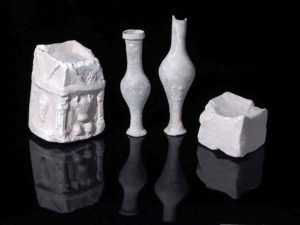King Herod’s Winery at Herodium
Archaeological excavations conducted at the Herodium National Park over the past year by the Ehud Netzer Expedition of the Institute of Archeology at the Hebrew University, headed by archaeologists Roi Porat, Yakov Kalman and Rachel Chachy, have revealed King Herod’s winery. In the structure that surrounds the circular palace/fortress they discovered dozens of huge jugs packed into a storage area, as well as ten pits that likely functioned as fermentation tanks. In addition, dozens of amphorae were unearthed which bear inscriptions and seals revealing that they were once produced in Italy and then shipped by sea to Iudaea. These discoveries shed light on the drinking habits of the royal family.
The earliest remains of Homo Sapiens outside of Africa found at Mt. Carmel
A fossil of an upper jawbone and stone tools were found in Misliya cave, located on Mount Carmel, during a prehistoric excavation headed by Dr. Mina Weinstein-Evron from Haifa University and by Prof. Israel Hershkovitz from Tel Aviv University. The researchers determined that the jawbone is from Homo Sapiens. The Misiliya fossil was dated back to 170,000-190,000 years ago by several different techniques, including uranium isotope analysis. The discovery hints that the trek of Homo Sapiens out of Africa should be pushed back by more than 40,000 years from the time suspected until now.
High-quality Roman Mosaic revealed at Caesarea

A multicoloured Roman mosaic from the 2nd–3rd centuries CE, bearing an inscription in ancient Greek, has been uncovered at the Caesarea National Park during an excavation on behalf of the Israel Antiquities Authority headed by Dr. Peter Gendelman and Dr. Uzi Ad. The excavation revealed a large building from the Byzantine Period that was part of a commercial area. Under the Byzantine-era structure they found a Roman-era building paved with a mosaic. According to the directors of the excavation, the colorful mosaic, measuring more than 3.5 x 8 meters, is of a rare high quality. It features three figures, multicolored geometric patterns and a long inscription in Greek, which were damaged by the Byzantine building constructed on top of it. The figures, all males, wear togas and apparently belong to the upper class. The mosaic was executed at a very high artistic level, of a type that can be found in places like Antioch in Turkey. The images were depicted using small tesserae, with about 12,000 stones per square meter.
Byzantine Monastery Discovered at Ramat Beit Shemesh

Well-preserved remains of a Byzantine monastery and church were unearthed in Ramat Beit Shemesh, close to Khirbet Beit Battif, during an excavation of the Israel Antiquities Authority. The expedition uncovered a massive structure built of large hewn stones, as well as a number of architectural elements, such as an imported marble pillar base decorated with crosses. One room of the monastery was paved with colourful mosaic decorated with birds, leafs, and pomegranates. The structure was abandoned during the 7th century CE. According to Benyamin Storchan, the director of the excavation, the artifacts found in the large building may indicate that the site was important and perhaps a center for ancient pilgrims in the Judean foothills region.
An Idumean Temple/Palace Unearthed In Southern Judean Foothills

A massive structure from the Hellenistic Period (3-2 Centuries BCE), built from masonry stones, was excavated at Horvat ‘Amuda, some 3.5 Kilometers south-east of Tel Maresha. The excavation was held by Dr. Oren Gutfeld of the Hebrew University and Pablo Betzer and Michal Haber of the Israel Antiquities Authority. Evidence of the structure’s existence was documented during a drone survey conducted by the expedition in the area between Tel Maresha and Moshav Amazia.
In one of the rooms excavated at the site, two stone incense altars were uncovered. One of the altars was found adorned by a crouching bull set inside the entrance of a temple’s façade adorned with decorated columns. The directors of the excavation suggest that this may have symbolized a deity worshipped by the Idumeans. Additional findings include painted bowls, juglets and oil lamps from the Hellenistic Period. It appears that the Idumean structure was intentionally dismantled, perhaps during the Hasmonean conquests of the region.
Dr Eitan Klein is a Deputy Director of the Unit for the Prevention of Antiquities Looting in the Israel Antiquities Authority, an Archaeologist of the classical periods and a Lecturer at the Land of Israel Department at Ashqelon Academic College

